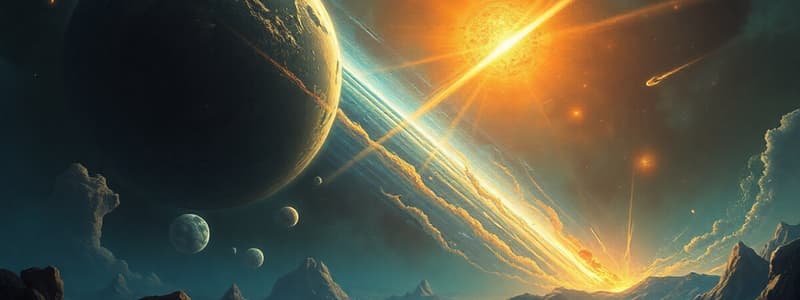Podcast
Questions and Answers
What was the explosive force of the meteorite that struck Chelyabinsk?
What was the explosive force of the meteorite that struck Chelyabinsk?
- 500 kilotons (correct)
- 100 kilotons
- 10 megatons
- 1 megaton
The meteorite that exploded in Chelyabinsk was about 50 meters wide.
The meteorite that exploded in Chelyabinsk was about 50 meters wide.
False (B)
What year did the Chelyabinsk meteorite event occur?
What year did the Chelyabinsk meteorite event occur?
2013
Comets are primarily made up of _____ and ice.
Comets are primarily made up of _____ and ice.
Match the following objects with their descriptions:
Match the following objects with their descriptions:
What is believed to have wiped out the dinosaurs?
What is believed to have wiped out the dinosaurs?
Asteroids pose no threat to human existence.
Asteroids pose no threat to human existence.
What is the diameter of the object thought to have caused the extinction of the dinosaurs?
What is the diameter of the object thought to have caused the extinction of the dinosaurs?
The gravitational field of _____ helps protect Earth from dangerous space rocks.
The gravitational field of _____ helps protect Earth from dangerous space rocks.
How often do bright comets typically appear in the night sky?
How often do bright comets typically appear in the night sky?
Flashcards
Chelyabinsk meteorite
Chelyabinsk meteorite
A relatively small asteroid that exploded over Chelyabinsk, Russia, in 2013, causing significant damage.
Asteroid
Asteroid
A rocky object orbiting the Sun, ranging in size from a few feet to several kilometers.
Comet
Comet
A ball of rock and ice that orbits the Sun, often with a visible tail of gas and dust.
Dinosaur extinction
Dinosaur extinction
Signup and view all the flashcards
Asteroid impact threat
Asteroid impact threat
Signup and view all the flashcards
Jupiter's role
Jupiter's role
Signup and view all the flashcards
Asteroid size and damage
Asteroid size and damage
Signup and view all the flashcards
Asteroid impact risk
Asteroid impact risk
Signup and view all the flashcards
Meteorite
Meteorite
Signup and view all the flashcards
Cosmic threat
Cosmic threat
Signup and view all the flashcards
Study Notes
Earth's End-of-Life Threat
- Chelyabinsk Meteorite (2013): 17 meters wide, entered atmosphere at 64,000 km/h, exploded over Chelyabinsk, Russia, causing injuries from falling glass but relatively minor damage.
- Siberian Meteorite (earlier): 50 meters in diameter, exploded over a forest, flattening 80 million trees. Would have caused millions of deaths if over populated areas (e.g Moscow or London).
- Asteroid's Close Approach: A 50-meter asteroid passed close to Earth on the same day as the Chelyabinsk event, a known object expected to pass again in 2046. This was not a surprise, but the Chelyabinsk event was not anticipated.
- Dinosaur Extinction: Likely caused by an asteroid impact 65 million years ago (10–16 km diameter) in the Yucatan region, with an explosive force equivalent to 100 megatons (one Hiroshima bomb per Earth's current population).
- Asteroid Threat Severity: Asteroids more than 20 km in diameter could lead to global destruction of all animal and most plant life. Even relatively smaller objects can cause significant harm.
- Earth's Protection: Jupiter, with its large gravitational pull, has helped prevent frequent asteroid impacts on Earth.
- Increased Monitoring: Recent events have led to more careful monitoring of potential hazards, though there's no imminent danger currently.
Types of Space Rocks
- Comet: A ball of rock and ice, forming a gas and dust tail. Bright comets are visible about every 10 years.
- Asteroid: A rock ranging from a few feet to several kilometres in diameter, lacking a tail. Most are small and harmless, burning up in the atmosphere. They appear as shooting stars.
- Meteoroid: A fragment of an asteroid or comet.
- Meteorite: A meteoroid that impacts Earth's surface.
Studying That Suits You
Use AI to generate personalized quizzes and flashcards to suit your learning preferences.




